The pot you choose to grow your houseplants don’t just have to look trendy – they also contribute dramatically to the health of your plants. Different materials have different reactions to the environment, and knowing how to pick the right plant pot can set you on the right path to helping your plants have a long and happy life. This guide will review the basic types of containers, and help you pick the right container for your plants so they can thrive in your home.
Contents
Plastic Pots or Starter Pots
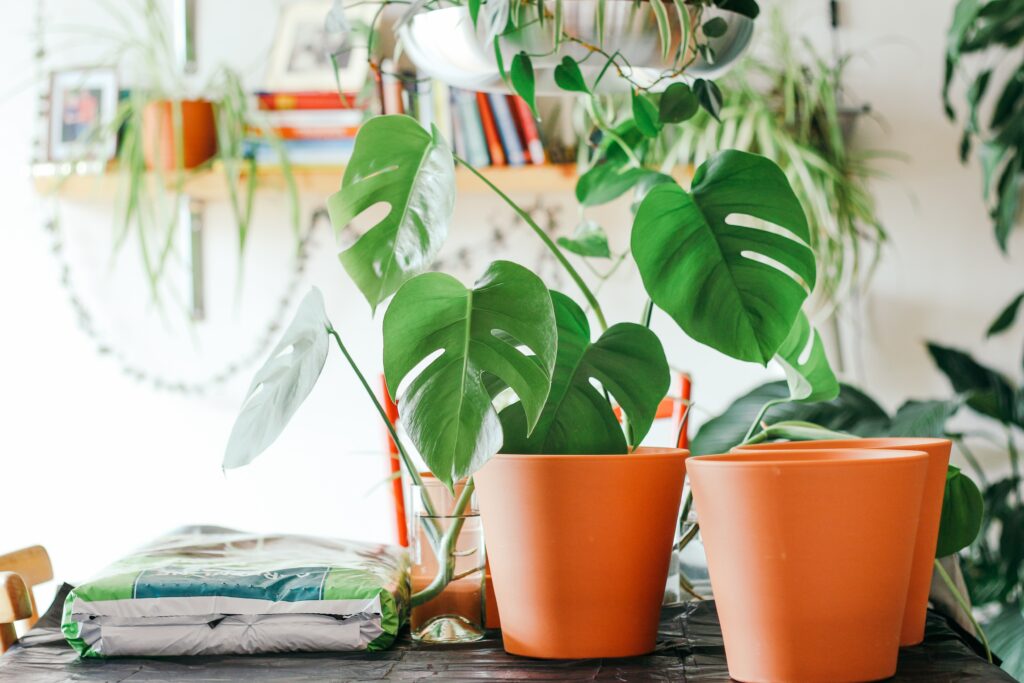
One of the most basic and widely used pots are simple nursery plastic pots. This abundant plant pot is easy to find, affordable and the ample drainage holes make it a great choice to easily regulate water. Could knowing how to pick the right plant pot mean a plastic pot works best for you? Here are some of the main things to consider if you’re thinking of planting up in a plastic container.
- By far the most affordable option, this mass-produced plastic container is likely the default pot you’ll find at your local nursery.
- Multiple drainage holes allow water to completely flow through the medium and through the pot, so no water is left sitting in the root area.
- While they have a pretty plain appearance, plastic pots can be easily inserted in decorative vases, pottery, woven baskets, or other designer containers for an instantly upscale look without the need to re-pot.
- If excessive roots begin reaching out of the drainage holes, this is an easy sign your plant is ready to be upgraded to a larger pot.
- Plastic is by far the most durable material of any on this list. If you have pets or children, plastic may be a good option to avoid shattering plant containers.
- Plastic materials are cheap, but problematic for the environment. To be more eco-conscious, choose a recycled plastic container, or consider up-cycling a container you may already have to minimize your environmental impact.
Terracotta or Clay Pots
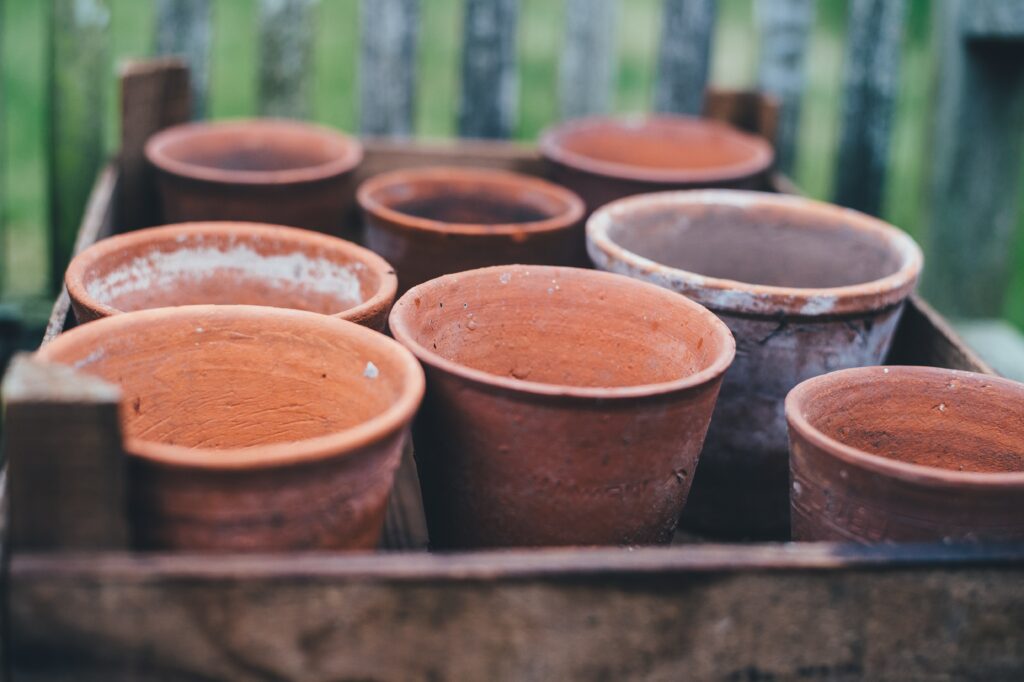
Terracotta is a timeless choice for plant containers. The iconic red-brown clay appearance is unmistakable, and instantly adds an earthy vibe to your environment. The unique porous nature of clay makes these pots a great choice for plants that prefer drier environments, but many plants can thrive in terracotta pots.
- The unfinished and porous nature of terracotta means that water can sweat from the sides of the container, allowing the soil to easily dry, even if overwatered.
- This is especially helpful for cactus and succulent houseplants, which prefer to have soil completely try between waterings.
- Over time, terracotta will also develop a beautiful white weathered patina, as water pulls minerals through the clay. This effect takes years, but happens faster in areas with harder water.
- Unlike plastic, terracotta is very breakable! While it’s also an inexpensive material, terracotta can easily crack or shatter if dropped.
- Terracotta can also shatter if left outside in cold winters. This happens when water inside of the clay expands as it turns to ice, forcing the clay to expand beyond its limits.
- Tropical plants can thrive in terracotta pots just like cacti. Tropical houseplants may need more frequent waterings – especially during the summer – as water can seep from the sides as well as the bottom drainage holes.
- Due to the porous material, terracotta pots should always have a plastic saucer or cork to avoid damaging floors or window sills as water can slowly pass, even if your pot has a terracotta saucer.
Ceramic Glazed Pots
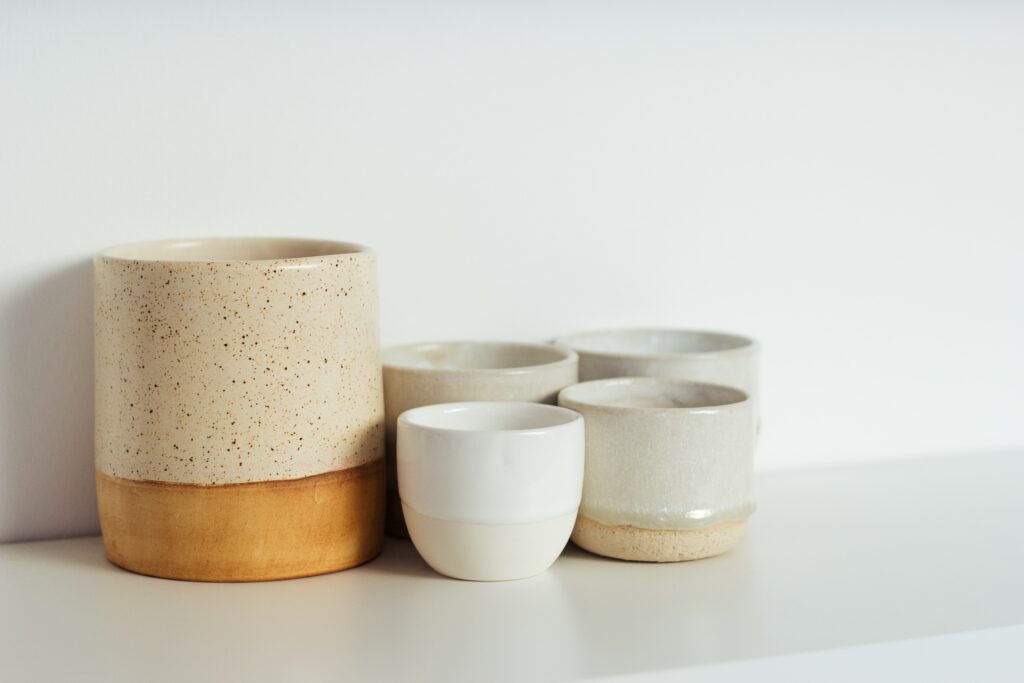
Glazed ceramic has many things in common with terracotta with the exception that a decorative layer is painted and sealed to the container in the kiln. While this production change means a near endless amount of designs are possible, it also helps seal in moisture compared to classic terracotta, making ceramic plant pots have unique characteristics a little different than traditional clay pots.
- Painted glaze adds a traditional and beautiful decor element that also means water cannot pass through anything but the bottom drainage hole, if present.
- Glazed ceramic pots are just as fragile as terracotta, and can chip, crack or break with accidental drops or if exposed to extreme cold weather.
- Like terracotta pots, it’s recommended to keep a plastic or cork saucer below the plant as small imperfections can develop over time, causing the pot to slowly leak water onto floors, shelves or tabletops.
- If your ceramic container does not contain drainage holes, any excess water will stay inside the container, potentially harming your plant. While it’s still possible to keep plants in such conditions, being careful on watering will ensure plants get enough water without being exposed to root rot.
- The artistic nature of ceramic pots means they typically run more expensive than other options in this guide, although many regard the containers as pieces of art and well-worth the cost.
Containers without Drainage
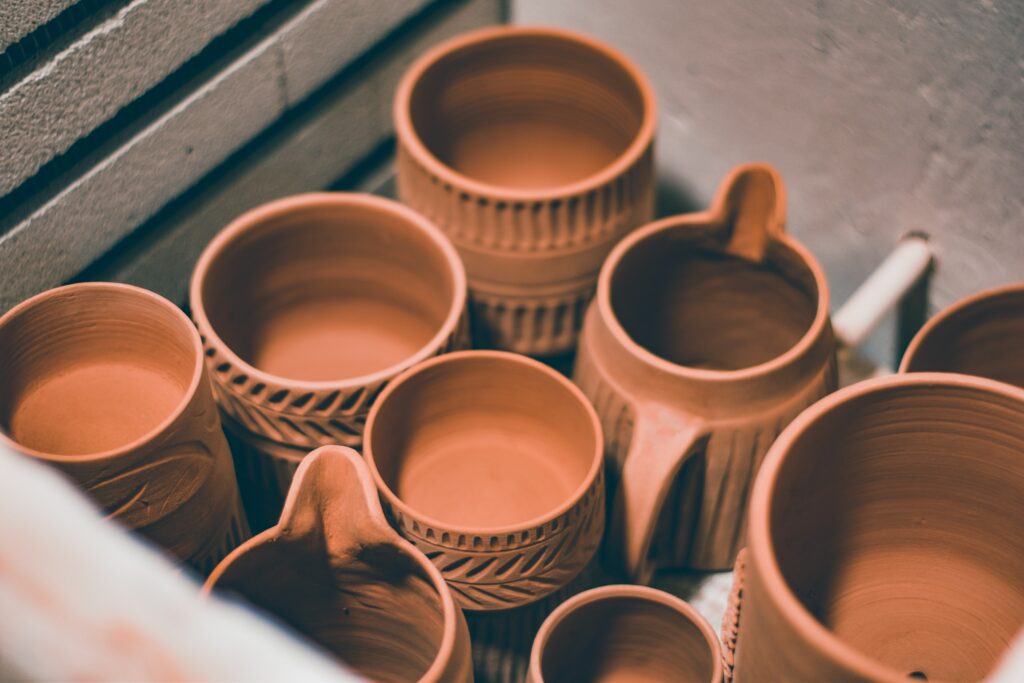
It’s very common to see plant pots from designer stores advertised without drainage holes. While most nurseries would never sell such a container, it’s still possible to cultivate houseplants in containers without drainage. However, there are special precautions to take to make sure you’re providing the best care to your plants without running the risk of overwatering them.
- If you find a beautiful container without drainage, consider planting your houseplant in a cheaper plastic pot, and then placing the entire pot within the container without drainage.
- This method ensures that you can still use your beautiful container, hides the plastic pot, and still allows for removal when it’s time to water.
- Watering thoroughly in a kitchen sink and allowing time to drain before returning to your original container could be the best balance for your plant.
- If you’ve already planted up in a non-drainage container, water meters can help gauge when soil is completely dry, and your plant is ready for water.
- If you haven’t already planted your container, consider bringing it to your nursery and seeing if they can drain a hole in the bottom. Many have the tools to do so for a nominal fee.
- Think gravel at the bottom of a pot provides enough drainage? Think again! Research at the University of Illinois shows that gravel or other substrate does little, if anything, to combat overwatering in containers without drainage.
- Overall, when we think of how to pick the right plant pot, we normally don’t jump to no-drainage containers, but if you found one that looks perfect, it may be possible to still make it work!
Containers with Drainage
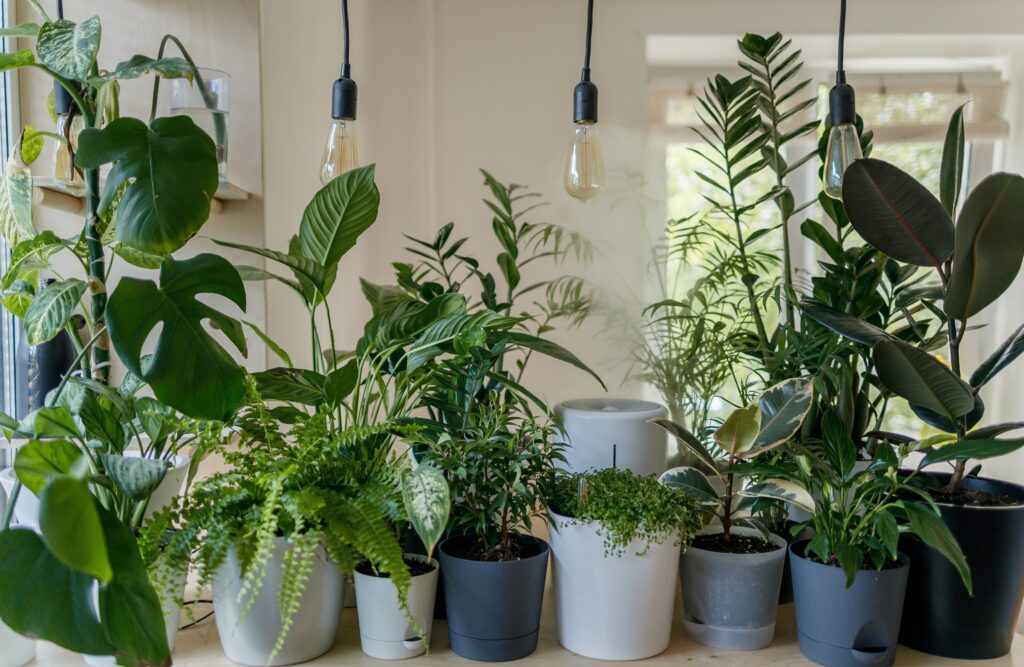
It’s no surprise that the easiest way to take care of plants are within containers that offer ample drainage holes. The flexibility of drainage holes means you can use water to not just rehydrate your plant, but to encourage strong and healthy roots.
- When watering, place your plant in your sink and water it vigorously. If space allows, use your faucet to soak the leaves to wash any dust off of them as well.
- Continue watering your plant even if you notice water running through the bottom drainage holes. This will not just take care of hydrating the root system, it will also encourage roots to grow more strongly vs. stopping the tap once you notice runoff.
- When the water stops streaming from the bottom (usually after a few minutes) you can wipe the bottom dry and return your plant to its place.
- Worried about soil running out of the drainage holes? A simple coffee filter will help keep soil in, but allow water to filter through.
Glasses or Vases
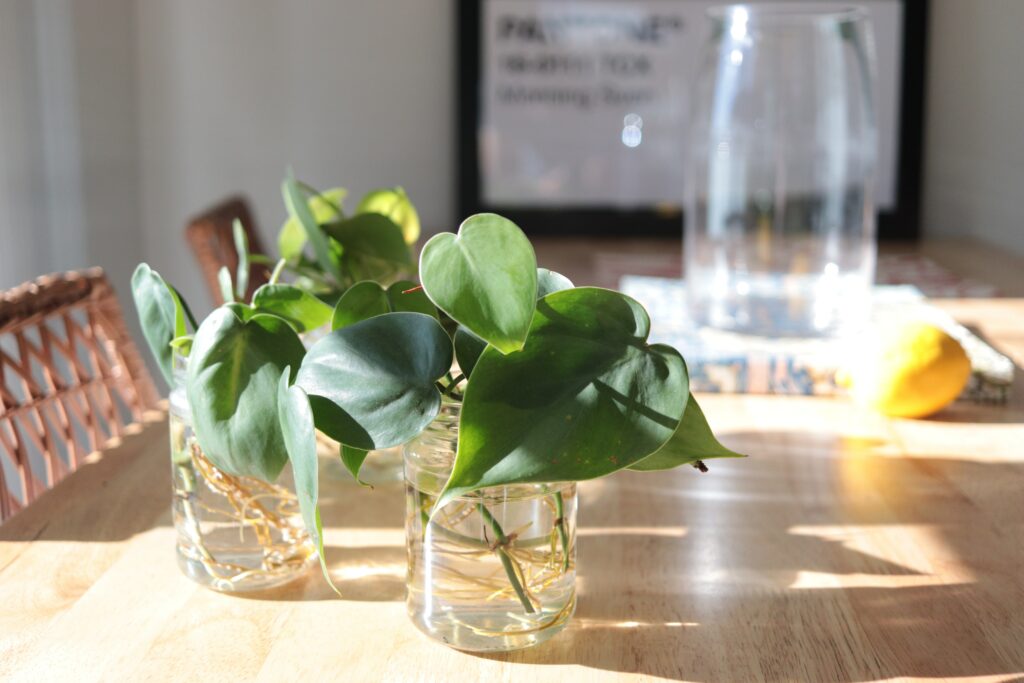
Glasses are popular go-to containers for propagating new plants since it makes it very easy to check on root growth as the plant develops. The variety of sizes and shapes also makes glasses a flexible option to propagate or keep cuttings long-term.
- Shot glasses are perfect for small cuttings like succulents, spider plants or philodendrons. The small size and narrow mouth make them perfect to keep cuttings upright while providing enough water to help these plants develop roots.
- Larger vases and mason jars are perfect for Monstera plants or other larger leaves to stay upright while developing large root systems.
- Multiple cuttings can be placed in the same glass to help the group stay upright.
Regardless of the plants grown, water should be changed at least weekly to keep the plants in good health. - Glasses might not be to of mind when thinking how to pick the right plant pot, but they are very flexible containers, and indispensable when it comes to plant propagation.
Terrariums
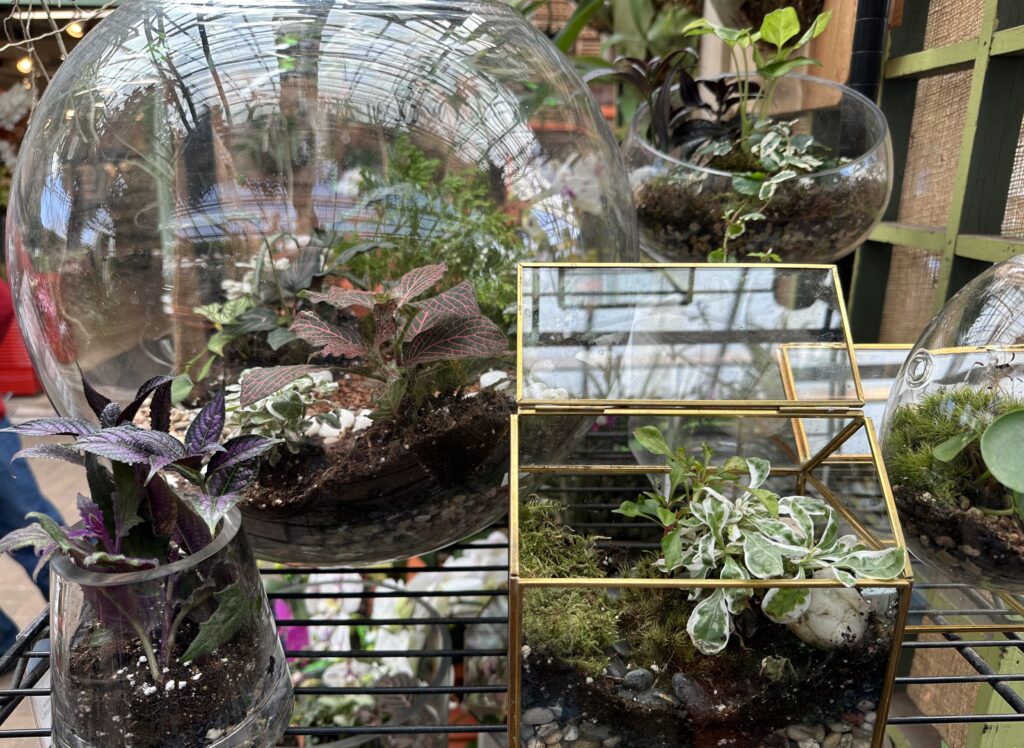
Unlike glasses or vases used for water propagation, terrariums include soil for a long-term home for houseplants. If you’re interested in planting up a DIY terrarium of your own, take a look at our new terrarium guide to understand the basics of terrarium care and which plants work best in these beautiful containers.
How to Pick the Right Plant Pot – Wrapping Up
There have never been as much interest in houseplants, or different types of containers to grow them in. A simple understanding of the material differences in materials, as well as the different needs required by plant pots with and without drainage can help you be a more informed consumer and a better plant parent. Interested in more plant guides? Take a look at our recommendations for the best air purifying plants, or our pick of plants that are the easiest to keep alive.

